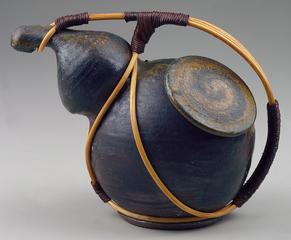
 |
Two very different cultures contributed to the creation of this teapot. It embodies a Japanese sense of tradition mixed with an American spirit of ingenuity and exploration. It was made by Richard Bresnahan, an American master potter who studied under Nakazato Takashi, a thirteenth-generation potter in Japan. Bresnahan's work is the culmination of many lessons learned during his study in Japan, from discussions with other potters, and through his own experimentation and observation.
 |
Bresnahan is ARTIST-IN-RESIDENCE and also a teacher at St. John's University in Collegeville, Minnesota. St. John's relationship to a Benedictine abbey and monastery plays a role in his work, as do the people and resources of the surrounding larger community. The artist's pottery is part of a living Minnesota heritage, a product of the rural, farming community in which he lives and works. Because Bresnahan draws his primary materials from the earth, trees, and crops native to the area, and he relies on the knowledge of people who have worked the land for many years, the same pottery could not be created within a large urban environment. In October of 1995 this pot came out of the first firing of a special wood-fueled kiln designed by Richard Bresnahan himself.
Key ideas.
Where does it come from?
What does it look like?
How was it used?
How was it made?
How big is it?
Who Knows?
Additional resources.
